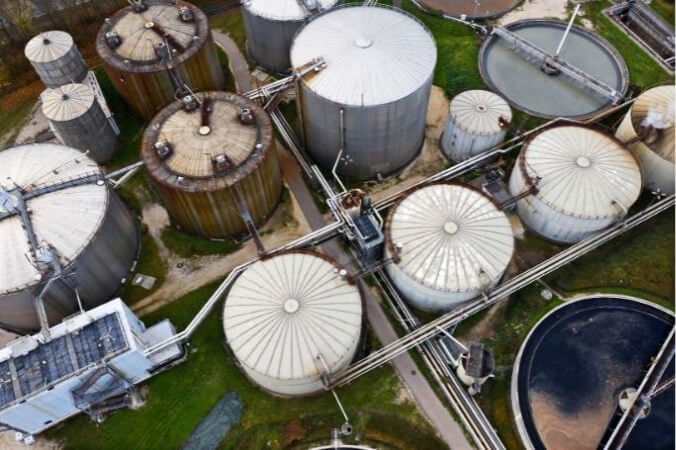Automation Systems Used in Wastewater Treatment Facilities
Critical infrastructures like wastewater facilities are largely automated. Let’s dive into the automation systems used in wastewater facilities.
What is a Wastewater Treatment Plant?
A wastewater facility treats polluted water to remove hazardous constituents from the wastewater. After treatment, the water becomes safe for natural disposals, such as dumping in waterways or using for agriculture purposes.
Historically, returning wastewater to the environment or nature was an effective and safe means of disposal. However, after the industrial revolution, the pollutants have become more hazardous than at any other time in history. It requires removing or neutralizing these hazardous constituents before being dumped naturally.

Figure 1. A wastewater treatment plant has many tanks on-site.
There can be many steps or processes in a treatment facility, depending upon the waste and degree of hazard. Examples of processes include simple settling methods or chemical treatments such as chlorine. Facilities may also use ultraviolet to remove the harmful mechanisms.
Automaton in Wastewater Treatment
The wastewater facility consists of multiple stages, and the output of each process becomes the input of the following process. Like other industries, wastewater facilities use automation techniques with many control components and instruments.
Common automated processes include pumping stations, grit chambers, aeration tanks, environmental emissions, anaerobic digestion (biogas systems), and cogeneration and combined heat and power (CHP) systems. Let’s dive into these automation systems.
Pumping Station
The pumping station is comprised of a large storage tank for storing the incoming wastewater from various individual sources. Upon reaching a pre-determined level, pumps transfer the wastewater to the next stage.
A level switch is installed in the station’s storage tank, which monitors the tank’s level. The level switch signals the main controller when the tank’s level falls below the set value. The main controller starts the pump to fill the tank. Similarly, the main controller stops the pump when the tank reaches the set value.
Flow sensors are also installed on the pumping stations to effectively control the incoming and outgoing liquid flow. The flow control measurements are necessary to adjust the flow relative to the tank storage capacity. Note that the pump is automated to adjust with different flow requirements and automatically starts/stops operation and adjusts its speed in response to changing flow requirements.
Grit Chamber and Aeration Tank
The grit chamber removes the wastewater’s suspended particles and requires accurate flow measurements together with the particle count to adjust the wastewater flow.

Figure 2. Wastewater is treated with an aeration tank.
In an aeration tank, dissolved organic compounds are organically decomposed and separated from the wastewater. A mass flowmeter measures wastewater’s flow together with the suspended particles.
Aeration occurs with blowers that keep the particles suspended while the mass flow meters continuously monitor the inlet and outlet for wastewater flow and adjust the blower parameters.
Environmental Emissions
It is usual for the wastewater treatment plant to emit air containing different biological traces, and these emissions are necessary to monitor. They provide insight into treatment performance, help control the environment, and help maintain emissions data. Additionally, this helps comply with regulatory body requirements such as the Environmental Protection Agency (EPA) in the U.S.

Figure 3. A gas tank used at a wastewater facility.
In the wastewater treatment facility, gas detectors monitor the emissions. The sensors used should detect emissions as low as 0.25 SFPS [0.08 NMPS]. Before passing the emission through the gas detectors, moisture must be removed from the emission. If it is impossible to remove water from the emissions, it is necessary to select such an instrument that is unaffected by the moisture content.
Anaerobic Digestion / Biogas Systems
Anaerobic digestion takes place in a sealed vessel, often called a reactor. The reactor breaks down the organic waste with the help of digester gases, such as methane and CO2. The reactor's output includes solid, liquid, and gaseous compounds and can be used for many applications, such as renewable natural gas (RNG).
In anaerobic digestion, the digester gas' flow is monitored to ensure the output parameters do not drift away from the standard. The measurement also allows for controlling emissions.
Cogeneration and Combined Heat and Power (CHP) Systems
The output of wastewater treatment plants may include biogas, which can be used as an energy source. Biogases produced by digesters in wastewater treatment plants can be used in place of natural gas for applications such as electricity generation, steam production, and heating.
Wastewater facilities have a natural by-product of digester gas, producing biogas. Biogas can be used instead of natural gas. Its calorific value is adjusted to replicate natural gas.
Flow meters monitor the digester gas and maintain calorific value, ensuring the output gas contains maximum thermal capability.
As you can see, there are several automation subsystems used in wastewater treatment plants. Within these subsystems are the instrumentation tools. In the following article, we will review the instrumentation within these systems and how they help automate processes.






